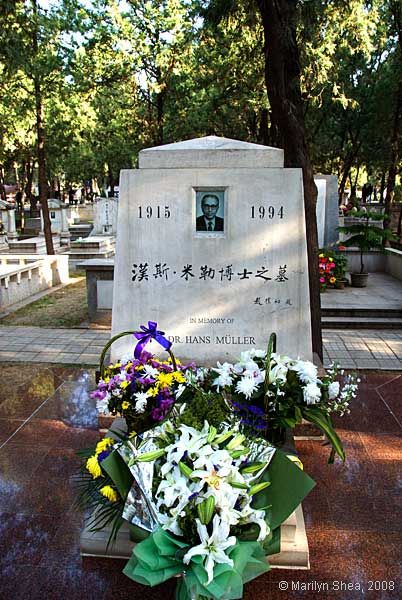 |
| Dr. Hans Müller 汉斯•米勒博士 (Hànsī Mǐlèbóshì) was a German, born in 1915 in Dussledorf to Henriette and Simon Fred Müller. Hans was their only child. Although his father owned a large electrical goods factory in Dusseldorf, Hans went to study medicine in Switzerland from 1933 to 1939.
His mother visited him in Switzerland in 1939. Hans never returned to Germany. His father was Jewish, although his mother was not. While Henriette returned to Germany, Hans left Switzerland and went to Shanghai. There, he practiced medicine, starting several projects to aid children. In the same year, he moved on to Yan'an to join in the fight against Fascism and Japan. He accompanied the army and served on the front, saving lives when he could. Following the war, he remained in China and worked to improve medicine in China. He was given several awards for his service, most notably in 1989, the PRC Ministry of Health named him "Outstanding International Medical Worker. It was the 50th anniversary of his arrival in China. Simon Müller was transported to the Thereseinstadt concentration camp in 1943 and the Nazis confiscated his property. He was liberated in 1945 and died in 1952. Henriette died in 1949. There is nothing to suggest that they ever saw their son again. China was still in turmoil. Perhaps they were able to send letters or at least get news. Hans Müller married Kyoko Nakamura and they had a daughter, Mimi Müller. Hans Muller died in 1994, but it wasn't until 2004 that his widow, Kyoko, made claim to monies left in a Swiss account by her mother-in-law, Henriette, when she visited Hans in 1939. The account was valued at 162,500 Swiss francs, about $150,000. It is amazing that neither Henriette nor Simon Müller made claim to the account. It is probable that Henriette deposited the money as a safeguard for their son. He never needed it. But it was there to secure the old age of his wife and the future of his daughter.
In 2007, Kyoko Nakamura donated some of his letters and personal items to the Anti-Japanese War Museum in Beijing. |
http://hua.umf.maine.edu/China/Babaoshan/index.html
Last
update: July 2009
© Marilyn Shea, 2009